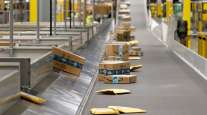Consumer Spending in Third Quarter Paces 2% Economic Growth

The U.S. economy expanded at a revised 2% annualized rate in the third quarter, buoyed by consumer spending as businesses struggled to sell to overseas customers battered by sluggish growth.
The gain in gross domestic product followed a 3.9% advance in the second quarter, Commerce Department figures showed Dec. 22. The median forecast of 76 economists surveyed by Bloomberg called for a 1.9% increase compared with the previously reported 2.1% pace.
Even with the slight reduction in growth, household purchases propelled demand last quarter as employment improved and fuel prices remained low. Nonetheless, consumers alone won’t be able to shoulder the burden of helping the world’s largest economy overcome slower global growth, so areas such as business investment and government outlays also will need to strengthen.
“There is some concern that consumption can’t drive GDP forever — other parts of the economy will have to create some tailwinds to really help growth along,” Gennadiy Goldberg, a U.S. rates strategist for TD Securities in New York, said before the report.
Economists’ projections for GDP, the value of all goods and services produced, ranged from 1.5% to 2.1%. The latest estimate is the third for the quarter, and the reading won’t be updated again until annual revisions are issued in July.
The economy grew at an average pace of 2.3% in the first half of the year after expanding 2.4% in all of 2014.
The slight reduction in third-quarter growth reflected a smaller increase in inventories than previously estimated. Consumer spending was little changed from the prior report as a reduction in outlays on financial services was offset by a bigger gain among nonprofit agencies serving households.
Weaker overseas growth and a strong dollar have weighed on net exports, with trade subtracting 0.3 percentage point from overall growth after adding 0.2 percentage point in the prior three-month period. Sustained growth in the United States combined with weakening in other parts of the globe, including in China, could widen the gap between exports and imports in the quarters ahead.
Inventories subtracted 0.7 percentage point from growth compared with a previous estimate of a 0.6 percentage-point drag. A buildup in stockpiles for much of this year, exacerbated by weaker-than-expected overseas demand, still is being drawn down.
Corporate spending on equipment advanced at a 9.9% annualized pace, adding 0.6 percentage point to growth and the biggest gain in a year.
Household purchases, which account for almost 70% of the economy, rose at a 3% annual pace, the same as previously estimated. Personal consumption added 2 percentage points to growth.
Steady payroll gains and cheap gasoline are helping support Americans. Payrolls have advanced at a 210,000 average monthly pace this year through November, compared with a 260,000 average for all of 2014 that was the strongest in 15 years.
Costs at the gas pump are at their lowest since 2009, having fallen steadily for four months on a slide in global commodity prices. The average price of a gallon of regular gasoline was $2.00 as of Dec. 20, the lowest since March 2009, according to auto group AAA. That compares with a daily average in 2014 of $3.34 per gallon.
Cutbacks in public spending also will probably no longer hinder growth in 2016 after Congress and the Obama administration agreed last week to fund the government through September. Outlays at the federal level will grow 2.6% next year, the first gain since 2010, according to Dec. 18 estimates by economists at Goldman Sachs Group Inc. in New York.
The momentum in U.S. demand has given Federal Reserve policymakers enough confidence that the economy can withstand the first increase in the benchmark interest rate in almost a decade. Chair Janet Yellen announced Dec. 16 that the central bankers unanimously voted to raise the rate by a quarter-point from near zero.
“The economic recovery has clearly come a long way, although it is not yet complete,” Yellen said in Washington. “The committee currently expects that, with gradual adjustments in the stance of monetary policy, economic activity will continue to expand at a moderate pace and labor market indicators will continue to strengthen.”
Policymakers’ forecasts show the central bank will raise the benchmark interest rate by 1 percentage point next year.
“The U.S. economy is really just chugging along at a fairly middling pace, but it’s enough for the Fed to continue delivering rate hikes,” TD Securities' Goldberg said.
The Dec. 22 GDP report also showed prices tied to consumer spending, excluding food and fuel, rose at a faster pace in the third quarter than previously estimated, which also may alleviate concern with too-low inflation. The core consumption price index climbed at a 1.4% annualized rate from July through September compared with the 1.3% gain previously reported.




